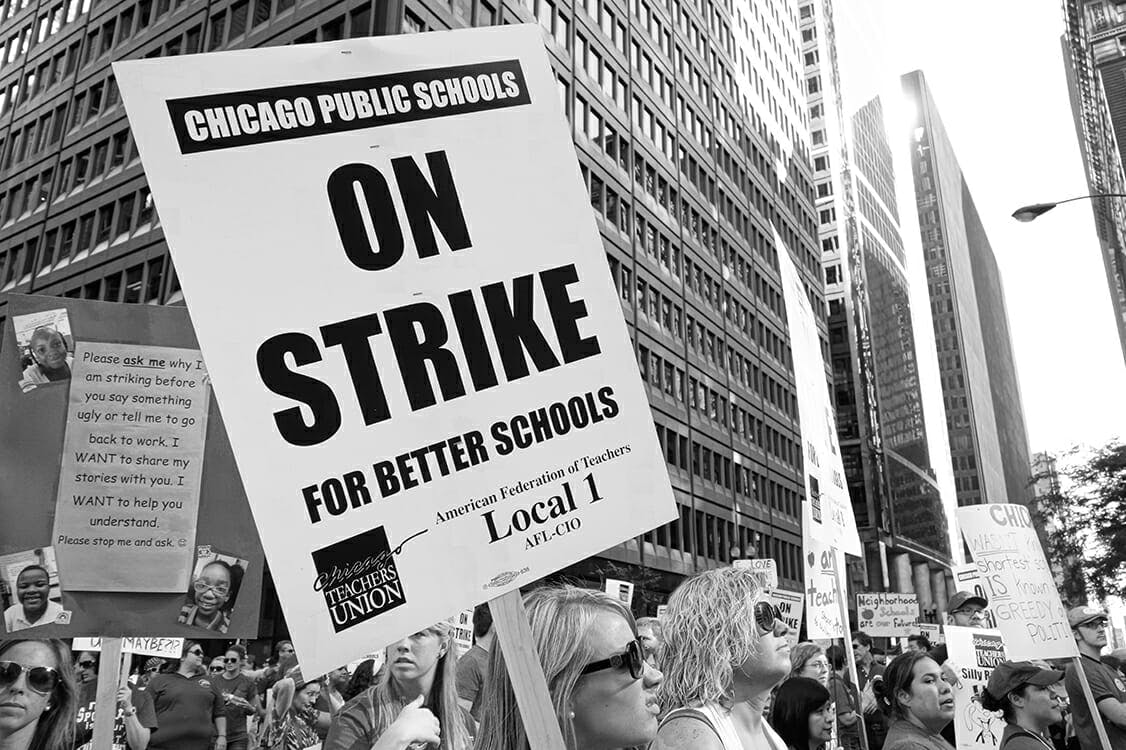After more than a week on the picket lines, West Virginia teachers announced on Tuesday that they would return to work. They’ll be going back after winning some big concessions, most notably the five percent raise that brought them out on the line in the first place.
More impressive, after the first two days on the line, the action became a “wildcat strike,” meaning that the strike was carried out by the workers without the blessing of state union officials. As the emerging progressive movement in America was inspired by the teachers and the nation’s conservative forces watched with worry, we are left with a big question: What state could be next?
West Virginia teachers rank 47th in terms of pay. Only Mississippi, North Carolina, Oklahoma, and South Dakota rank lower. However, these numbers don’t tell the whole story. Since the cost of living varies state by state, many teachers in states with higher wages are living under similar conditions. Additionally, a pay raise wasn’t the only issue that prompted the West Virginia teachers to walk out. They were looking for a health insurance fix, and many cited the implementation of a mandatory Fitbit style app called “go365” to track their exercise time as the last straw that led them out the door.
There are also particular cultural conditions in West Virginia that helped lead to the strike. As one teacher told Scalawag, “[West Virginia has] a really big history when it comes to unions, and the UMWA [United Mine Workers of America] especially. So a lot of people have a family member who went through a strike, or who worked for a union mine of some sort. And people are really proud of that.”
Instead of trying to figure out which teachers have it worst (we can agree that none have it easy), let’s look at what the teachers’ unions themselves have said about following West Virginia to the picket line.
Oklahoma

Of the states that could follow West Virginia’s lead, Oklahoma looks most ready to follow suit. Like West Virginia, Oklahoma ranks near the bottom in terms of teacher pay, and teachers there have not seen a pay increase in a decade. State politicians promised a pay raise in 2016 but failed to deliver. Lawmakers did, however, manage to pass an income tax break for the wealthy in 2013 and a battery of tax breaks for the oil industry the following year.
As in West Virginia, teachers in Oklahoma also have a history of strikes. In 1990, they held a four-day strike that resulted in a pay raise.
Teachers in Oklahoma have already taken steps towards planning a strike, including announcing potential strike dates. Initially April 2, a date slated for statewide standardized testing, was floated, but the teachers have since landed on April 23. The teachers’ union held a press conference on Thursday demanding a $10,000 per teacher raise. The Oklahoma Education Association also says they have over 80 percent support for a walkout and some teachers will begin “work-to-rule” work slowdowns (doing the bare minimum required for the job) as early as next week.
Arizona

Teachers in Arizona may also be gearing up for a strike, though they are earlier on in terms of planning than educators in Oklahoma. On Wednesday, teachers in the state wore red to work to indicate their support for a work stoppage, with the accompanying hashtag #RedForEd.
Adjusted for cost of living, studies have found that Arizona teachers stand alongside Oklahoma as the lowest paid teachers in the nation. Like Oklahoma and West Virginia, Arizona has seen a shortage of qualified educators in recent years, and they have difficulty retaining talent. Lawmakers insisted that Arizona teachers tighten their belts during the recession, and funding has not been restored nearly a decade later.
While Arizona and Oklahoma look most likely to hit the picket line next, teachers in a number of other states have started talking about wildcat strikes. Kentucky teachers are currently engaged in a fight with lawmakers over pay and benefits. Pennsylvania teachers may also walk out; Pittsburgh teachers narrowly averted a strike last week.
Challenges
While the West Virginia teachers have inspired many, their experience also offers some notes of caution for future strikers. Yes, the strike got better results than Wisconsin teachers in 2011, who opted to push for a failed recall of Scott Walker rather than a strike. However, while West Virginia teachers got their pay raise, they did not get a deal done on a long-term fix for Public Employees Insurance Agency (PEIA) which handles state employee healthcare.
Furthermore, the Republican-dominated state legislature has opted to pay for the salary increase through cutting spending on things like community college, tourism, and potentially Medicaid. This is an old conservative trick, acting like you have to rob Peter to pay Paul when in fact, you could rob the robber barons by increasing taxes on the wealthy and corporations. The teachers wanted the salary bump to come from a tax increase on natural gas severance instead.
As progressive reporter and Appalachia native Sarah Jones put it in the New Republic, “the deal shows the limits of progressive activism in cash-strapped states where conservative legislators refuse to raise taxes on big business. When the pool of available cash is small, cuts tend to come at the expense of those who need it, not wealthy campaign donors.”
The question remains if teachers in other states will enjoy the same success as West Virginia teachers. Tactics like spending cuts meant to demonize teachers may work in states with equally challenged economies but with less history of union activism.
Despite these risks, many teachers feel that there is only one way to find out what kind of power they have: go on strike.


